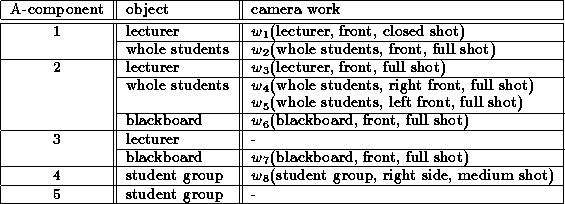 consists of the two-tuples, A-component and
the camera-works.
The A-component includes several objects and
the camera-work is designed for only one object.
Therefore, each A-component generally has a set of the
camera-works.
consists of the two-tuples, A-component and
the camera-works.
The A-component includes several objects and
the camera-work is designed for only one object.
Therefore, each A-component generally has a set of the
camera-works.
Publication,
Research,
Docs and Info,
KAMEDA
An imaging rule is a set of functions from a dynamic situation to camera-works .
Hence, the imaging rule  consists of the two-tuples, A-component and
the camera-works.
The A-component includes several objects and
the camera-work is designed for only one object.
Therefore, each A-component generally has a set of the
camera-works.
consists of the two-tuples, A-component and
the camera-works.
The A-component includes several objects and
the camera-work is designed for only one object.
Therefore, each A-component generally has a set of the
camera-works.
The dynamic situation in the real space varies as time is passed. This is detected by the sensors, and the situation features are extracted. Referring to the other representation of dynamic situation, i.e. situation feature representation, the dynamic situation is detected.
Let us explain by an example. Suppose the user defines the imaging rule
 like
Table2 against the A-components
shown in Table1. The empty rows
in the Table2 mean that the user
does not want to image the object (lecturer of the A-component No.3 for
example) even if the corresponding A-component is detected.
like
Table2 against the A-components
shown in Table1. The empty rows
in the Table2 mean that the user
does not want to image the object (lecturer of the A-component No.3 for
example) even if the corresponding A-component is detected.
If the A-component No.1 and No.4 are detected in the real space at time t,
the imaging rule  consists of three camera-works
consists of three camera-works  and
and
 in Table2 and represents the
request of the user at that time.
in Table2 and represents the
request of the user at that time.
Whereas a certain imaging rule is defined by one director in conventional remote lecturing system or ordinary multimedia video generation, our approach allows all the users to define imaging rules so that they can proclaim their favorite imaging ways.

Table 2: An example of imaging rule